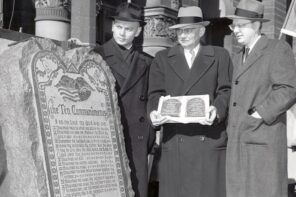The blockbuster movie Avatar has garnered critical and commercial success, netting $760,000,000 in two weeks. The 3-D effects have mesmerized many critics, as viewers were transported to the hanging mountains and dreamscape of flora and fauna of planet Pandora. Others, such as Annalee Newitz, have criticized this sci-fi movie as rehashing white fantasy about race, since the white man eventually became the leader of the natives.
I saw the movie on New Year’s Day and found it offers much food for thought on an anti-imperial reading of the Bible. The movie retells Rahab’s story in the book of Joshua with an interesting twist. In that familiar story, Joshua sends two spies to search out the city of Jericho. The spies enter a Canaanite prostitute Rahab’s house. When the king of Jericho orders Rahab to surrender them, Rahab hides them and saves their lives. Rahab makes a pact with the spies and asks them to spare her and her family when Jericho falls.
In Avatar, planet Pandora is not only a land of milk and honey, but also has a large reserve of a precious metal unobtanium. The avatar of Jake is sent as a messenger to ask the natives to relocate so that the humans can mine the unobtanium. Jake learns the native ways, falls in love with one of them, and becomes so identified with the natives such that he helps them to fight against the colonizers. The movie invites us to look at the world from the point of the indigenous people—to see the beauty of their interconnected way of life and learn about their culture. By doing so, it invites us to look at the Bible from the side of Canaanites.
The Na’vi humanoids of Pandora worship the Goddess Eywa, and their sacred symbol is the gigantic Hometree. The roots of the Hometree connect to all other living organisms, because everything is connected in this world. While this may sound like a New Age moral tale, it also reminds us of the Canaanite Goddess Asherah, who was associated with the Tree of Life. This tree’s roots reaches to the lower abyss and the branches ascend to heaven. The Hebrew prophets have repeatedly warned against worshiping the Canaanite goddesses, who were connected with nature and Earth’s fertility. In Avatar, there is a moving scene in which the protagonists go to Hometree to pray to Eywa to save the planet. The Goddess, whose spirit animates the whole world, answers their prayers and offers them protection and hope. The ancient Goddess religion is affirmed and not condemned.
Jake can be seen as a hero-savior figure, and at one point he is tied up and almost killed. But the movie offers a different Jesus story and of redemption. Redemption is not brought about by offering blood sacrifice, or by killing an inoocent scapegoat. Salvation comes because the Na’vi become conscientized and they rise up in solidarity to fight against the colonizers. This theory of atonement is closer to the modern-day liberation theologians’ than the substitutionary theory of Anselm during the Crusades. The humanoids prevail not because of their might, but because they have befriended the environment and nature work in their favor.
The end of Avatar is counter-apocalytpic. The world does not end, though much destroyed, after the battle between good and evil. As foretold in the book of Revelation, the whore of Babylon—the colonizing empire—is devoured by beasts with heads and horns. The end is humane and yet ironic: the humans who survive the battle are not all killed, but sent back, albeit to what the Na’vi consider a dying world.
The movie is a story of white guilt—the white man needs to give up his way and be transformed. But it is also something more. It is a cinematic fable, in real 3-D, of how to remythologize biblical stories and interpret them in subversive ways.




